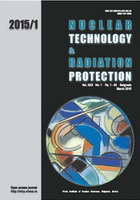
APPLICATION OF BEST ESTIMATE PLUS UNCERTAINTY IN REVIEW OF RESEARCH REACTOR SAFETY ANALYSIS
Pages: 75-82
Authors: Simon Adu, Ivan Horvatovic, Emmanuel O. Darko, Geoffrey Emi-Reynolds, and Francesco D'Auria
Abstract
To construct and operate a nuclear research reactor, the licensee is required to obtain the authorization from the regulatory body. One of the tasks of the regulatory authority is to verify that the safety analysis fulfils safety requirements. Historically, the compliance with safety requirements was assessed using a deterministic approach and conservative assumptions. This provides sufficient safety margins with respect to the licensing limits on boundary and operational conditions. Conservative assumptions were introduced into safety analysis to account for the uncertainty associated with lack of knowledge. With the introduction of best estimate computational tools, safety analyses are usually carried out using the best estimate approach. Results of such analyses can be accepted by the regulatory authority only if appropriate uncertainty evaluation is carried out. Best estimate computer codes are capable of providing more realistic information on the status of the plant, allowing the prediction of real safety margins. The best estimate plus uncertainty approach has proven to be reliable and viable of supplying realistic results if all conditions are carefully followed. This paper, therefore, presents this concept and its possible application to research reactor safety analysis. The aim of the paper is to investigate the unprotected loss-of-flow transients “core blockage” of a miniature neutron source research reactor by applying best estimate plus uncertainty methodology. The results of our calculations show that the temperatures in the core are within the safety limits and do not pose any significant threat to the reactor, as far as the melting of the cladding is concerned. The work also discusses the methodology of the best estimate plus uncertainty approach when applied to the safety analysis of research reactors for licensing purposes.
Key words: best estimate plus uncertainty, research reactor, RELAP5-3D, safety analysis
FULL PAPER IN PDF FORMAT (6.87 MB)
